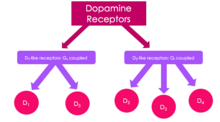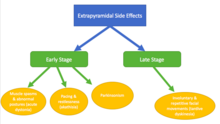R R Pharmacological Reviews 2011 63 (1) 182
| Dopamine receptor antagonist Dopaminergic blockers | |
|---|---|
| Drug class | |
 Skeletal structural formula of Haloperidol, a typical antipsychotic | |
| Class identifiers | |
| Utilize | Schizophrenia, bipolar disorder, nausea and vomiting, etc. |
| ATC code | N05A |
| Biological target | Dopamine receptors |
| External links | |
| MeSH | D012559 |
| In Wikidata | |
A dopamine antagonist, too known equally an anti-dopaminergic and a dopamine receptor antagonist (DRA), is a type of drug which blocks dopamine receptors past receptor antagonism. Near antipsychotics are dopamine antagonists, and equally such they take establish utilize in treating schizophrenia, bipolar disorder, and stimulant psychosis.[1] Several other dopamine antagonists are antiemetics used in the handling of nausea and vomiting.
Receptor pharmacology [edit]

Dopamine receptor menstruum nautical chart
Dopamine receptors are all G protein–coupled receptors, and are divided into two classes based on which 1000-poly peptide they are coupled to.[2] The Done-like class of dopamine receptors is coupled to Gαs/olf and stimulates adenylate cyclase production, whereas the D2-like class is coupled to Gαi/o and thus inhibits adenylate cyclase product.[ii]
D1-like receptors: D1 and Dv [edit]
D1-like receptors – Done and Dfive are always plant post-synaptically. The genes coding these receptors lack introns, so there are no splice variants.
D1 receptors [edit]
- D1 receptors are found mainly on neurons in the nucleus accumbens[three] as well as substantia nigra,[2] striatum,[two] amygdala,[2] frontal cortex[2] and olfactory bulb and retina[2]
- As well found (in lower levels) in the hypothalamus, thalamus, cerebellum and hippocampus[2]
- Peripherally, these receptors have been found in the renal avenue, mesenteric artery, and splenic artery where activation leads to vasodilation.[four] In addition, D1 receptors have been plant in the kidney[4]
Dfive receptors [edit]
- Depression levels of D5 receptors have been found in the hypothalamus, prefrontal cortex and cingulate cortex; every bit well as retentivity areas such every bit hippocampus, dentate gyrus and entorhinal cortex.[2]
- In addition, Dv receptors have been found in the kidney[4]
D2-like receptors: D2, D3 and Div [edit]
Dtwo-like receptors unlike the D1-like grade, these receptors are plant pre and mail service-synaptically. The genes that code these receptors take introns, leading to many alternately spliced variants.
D2 receptors [edit]
- Dtwo receptors are constitute in the striatum, substantia nigra, ventral tegmental area, hypothalamus, cortex, septum, amygdala, hippocampus, and olfactory tubercle.[two]
- These receptors have too been plant in the retina and pituitary gland.[2]
- Peripherally, these receptors have been constitute in the renal, mesenteric, and splenic arteries too as on the adrenal cortex and medulla and within the kidney.[4]
D3 receptors [edit]
- Diii receptors are highly expressed on neurons in islands of Calleja and nucleus accumbens vanquish and lowly expressed in areas such equally the substantia nigra pars compacta, hippocampus, septal area, and ventral tegmental area.[2] [3]
- Boosted studies have institute these receptors peripherally in the kidney[4]
Div receptors [edit]
- D4 receptors are found in amygdala, hippocampus, hypothalamus, globus pallidus, substantia nigra pars reticula, the thalamus, the retina and the kidney[ii] [four]
Implications in disease [edit]
The dopaminergic system has been implicated in a variety of disorders. Parkinson'southward illness results from loss of dopaminergic neurons in the striatum.[5] Furthermore, most effective antipsychotics block Dii receptors, suggesting a function for dopamine in schizophrenia.[five] [6] [7] Additional studies hypothesize dopamine dysregulation is involved in Huntington'due south disease, ADHD, Tourette'due south syndrome, major depression, manic depression, addiction, hypertension and kidney dysfunction.[5] [7] [8] Dopamine receptor antagonists are used for some diseases such as schizophrenia, bipolar disorder, nausea and vomiting.[v]
- Melatonin suppresses dopamine activity[9] as function of normal circadian rhythm functions, although pathological imbalances have been implicated in Parkinson's disease[10]
Side effects [edit]
They may include one or more of the following and last indefinitely even after abeyance of the dopamine antagonist, especially after long-term or loftier-dosage use:
- Cardiovascular disease[11] [12]

- Extrapyramidal symptoms (EPS) associated with typical antipsychotics:
- Early stage – occurs at onset of treatment or following increased dose, patients recover when dose is decreased[13]
- Acute dystonias[13] – muscle spasms and sustained abnormal postures and onset occurs inside a few days; can exist treated with anticholinergics
- risk factors include age, gender and family history[13]
- Akathisia[13] [14] - pacing and restlessness and onset occurs inside the start few months; tin can be treated with beta blockers and benzodiazepines
- Parkinsonism due to effects on the nigrostriatal pathway[thirteen] [fourteen] - includes tremors, bradykinesia and musculus rigidity
- run a risk factors include age and gender[13]
- Acute dystonias[13] – muscle spasms and sustained abnormal postures and onset occurs inside a few days; can exist treated with anticholinergics
- Tardily stage – occurs afterwards prolonged (months-years) treatment, symptoms persist fifty-fifty afterwards dose is decreased[13]
- Tardive dyskinesia[13] [xiv] - includes involuntary and repetitive facial movements
- risk factors include age, race and gender[thirteen]
- Tardive dyskinesia[13] [xiv] - includes involuntary and repetitive facial movements
- Information technology is hypothesized that these effects are due to chronic blockade of the D2 receptor[xiv]
- Early stage – occurs at onset of treatment or following increased dose, patients recover when dose is decreased[13]
- Hyperprolactinaemia due to blockade of the Dtwo receptors in the inductive pituitary leading to increased prolactin release[eleven] [15]
- Increased ambition including increased peckish and rampage eating that lead to weight gain[11] [16] [17]
- Increased risk for insulin resistance[xvi]
- Sexual dysfunction[11] [12]
- Metabolic changes with increased take chances of obesity and diabetes mellitus type 2[11] [xvi]
- Sedation[11] [12]
- Neuroleptic Malignant Syndrome[18] is a medical emergency acquired by a decrease in dopaminergic activity, resulting in a cardinal Dtwo receptor blockade.[xviii]
Examples [edit]
Starting time-generation antipsychotics (typical) [edit]
First generation antipsychotics are used to care for schizophrenia and are often accompanied by extrapyramidal side effects.[xix] They inhibit dopaminergic neurotransmission in the brain past blocking nigh 72% of the D2 dopamine receptors.[20] They can besides cake noradrenergic, cholinergic, and histaminergic activity.[20]
- Benperidol[19] binds D2 and some serotonin receptors.[21] Information technology is absorbed very easily and has a high offset pass outcome.[21]
- Chlorpromazine binds D3 with the highest analogousness, but besides binds D1, D2, D4 and Dfive [22] [23]

Chemical Construction of typical antipsychotic chlorpromazine
- Clopenthixol[19]
- Droperidol is used as an antipsychotic and antiemetic.[xix]
- Haloperidol binds D2, D3 and D4 with the highest affinity, but likewise binds Dane and D5. [19] [22] [23] Haloperidol also has a risk for QTc prolongation. [24]
- Fluphenazine binds D2 and D3 with the highest affinity simply D1 and D5 equally well[19] [22]
- Flupentixol binds D1, Dii, D3, and D5 [22] and is too used as an antidepressant.[xix]
- Fluspirilene[19]
- Penfluridol[19]
- Perazine[19]
- Perphenazine[19]
- Pimozide binds D2 and Diii with high affinity, likewise binds D4 receptors[19] [22]
- Spiperone binds D2, Dthree and D4 with high affinity; can besides bind Done [xix] [22]
- Sulpiride binds Dii and Dthree [19] [22] and is also used as an antidepressant.[19]
- Thioridazine binds D2, D3 and D4 with loftier analogousness; tin can likewise demark D1 and D5 at higher concentrations[22] Thioridazine has the highest associated risk of QTc prolongation amidst neuroleptics.[24]
2d-generation antipsychotics (atypical) [edit]
These drugs are not only dopamine antagonists at the receptor specified, simply also act on serotonin receptor 5HT2A. [20] [25] (Commendation inappropriate) These drugs have less extrapyramidal side furnishings and are less likely to affect prolactin levels when compared to typical antipsychotics.[26]
- Amisulpride binds D2 and D3 [27] and is used as an antipsychotic, antidepressant and also treats bipolar disorder.[25] It treats both the positive and negative symptoms of schizophrenia.[28]
- Asenapine binds Dtwo, Dthree and D4 [29] and is used to care for bipolar disorder and schizophrenia.[30] Its side furnishings include weight gain but there is lower risk for orthostatic hypotension, hyperprolactinemia
- Aripiprazole binds Dtwo as a fractional agonist just antagonizes D3. [31] In improver, aripiprazole treats schizophrenia, bipolar disorder (mania),[32] depression,[25] and tic disorders[31]

- Clozapine binds Di and D4 with the highest affinity but all the same binds Dtwo and Diii.[33] Clozapine is unique because it is simply prescribed when treatment with at to the lowest degree two other antipsychotics has failed due to its very harsh side furnishings.[34] It likewise requires weekly white claret cell counts to monitor potential neutropenia.[34]
- Loxapine binds D2, Diii and D4 with loftier affinity; can too bind D1. [35] Loxapine is ofttimes used to treat agitated and violent patients with neuropsychiatric disorders such as bipolar disorder and schizophrenia.[36]
- Nemonapride binds D3, D4 and D5. [37]
- Olanzapine binds all receptors[38] and is used to treat the positive and negative symptoms of schizophrenia as well as bipolar disorder and low.[39] It has been associated with significant weight gain.[forty]
- Quetiapine binds D1, Dtwo and D3 and tin can demark D4 at high concentrations.[38] Information technology is used to care for the positive symptoms of schizophrenia,[twoscore] bipolar disorder and depression.[39] Of the second generation antipsychotics, quetiapine may produce fewer parkinsonian side effects.[41]
- Paliperidone binds D2, D3 and D4 with high affinity; tin also bind Dane and Dfive.[42]
- Remoxipride binds D2 receptors with relatively low affinity.[38] [43] [39]
- Risperidone binds Dtwo, Dthree and Div receptors.[39] [38] [42] Risperidone non just treats the positive and negative symptoms of schizophrenia[forty] just also treats bipolar disorder.[39]
- Tiapride blocks D2 and D3 and is used as an antipsychotic.[39] Information technology is as well ofttimes used to care for dyskinesias, psychomotor agitations, tics, Huntington's chorea and alcohol dependence.[44]
- Ziprasidone blocks the Dtwo receptor[45] and is used to treat schizophrenia, low and bipolar disorder.[39] There is controversy on whether Ziprasidone treats negative symptoms and information technology has well documented gastrointestinal side effects.[forty] Ziprasidone tin can also cause QTc prolongation.[24]
Dopamine antagonists used to treat nausea and vomiting [edit]
- Domperidone is a peripherally selective dopamine D2 receptor antagonist used every bit an antiemetic, gastroprokinetic agent and galactagogue.
- Bromopride binds enteric D2 receptors[46] and as well treats gastroparesis.[47]
- Metoclopramide also treats gastroparesis[47]
Antagonists used only in research settings [edit]
- Eticlopride binds D2 and D3 with loftier analogousness merely also binds D4[48] [49] [50]
- Nafadotride binds Dii and Diii [47] [48] [49]
- Raclopride binds Dtwo and Dthree [47] [48] and can exist radiolabeled and used in PET imaging to identify affliction progression in Huntington'southward Disease[51]
References [edit]
- ^ Beaulieu JM, Gainetdinov RR (March 2011). "The physiology, signaling, and pharmacology of dopamine receptors". Pharmacological Reviews. 63 (1): 182–217. doi:10.1124/pr.110.002642. PMID 21303898. S2CID 2545878.
- ^ a b c d due east f yard h i j 1000 l m Beaulieu JM, Gainetdinov RR (March 2011). "The physiology, signaling, and pharmacology of dopamine receptors". Pharmacological Reviews. 63 (one): 182–217. doi:10.1124/pr.110.002642. PMID 21303898. S2CID 2545878.
- ^ a b Sokoloff P, Diaz J, Le Foll B, Guillin O, Leriche Fifty, Bezard E, Gross C (February 2006). "The dopamine D3 receptor: a therapeutic target for the treatment of neuropsychiatric disorders". CNS & Neurological Disorders Drug Targets. five (1): 25–43. doi:10.2174/187152706784111551. PMID 16613552.
- ^ a b c d eastward f Missale C, Nash SR, Robinson SW, Jaber M, Caron MG (January 1998). "Dopamine receptors: from construction to function". Physiological Reviews. 78 (1): 189–225. doi:ten.1152/physrev.1998.78.ane.189. PMID 9457173.
- ^ a b c d Beaulieu JM, Gainetdinov RR (March 2011). "The physiology, signaling, and pharmacology of dopamine receptors". Pharmacological Reviews. 63 (i): 182–217. doi:10.1124/pr.110.002642. PMID 21303898. S2CID 2545878.
- ^ Seeman P (Baronial 2006). "Targeting the dopamine D2 receptor in schizophrenia". Skillful Opinion on Therapeutic Targets. 10 (4): 515–31. doi:ten.1517/14728222.10.4.515. PMID 16848689. S2CID 30902536.
- ^ a b Missale C, Nash SR, Robinson SW, Jaber Thou, Caron MG (January 1998). "Dopamine receptors: from construction to function". Physiological Reviews. 78 (ane): 189–225. doi:10.1152/physrev.1998.78.1.189. PMID 9457173.
- ^ Iversen SD, Iversen LL (May 2007). "Dopamine: fifty years in perspective". Trends in Neurosciences. 30 (5): 188–93. doi:10.1016/j.tins.2007.03.002. PMID 17368565. S2CID 22686973.
- ^ Zisapel N (Dec 2001). "Melatonin-dopamine interactions: from bones neurochemistry to a clinical setting". Cellular and Molecular Neurobiology. 21 (half-dozen): 605–16. doi:10.1023/A:1015187601628. PMID 12043836. S2CID 25508148.
- ^ Willis GL (2008). "Parkinson'southward disease as a neuroendocrine disorder of circadian function: dopamine-melatonin imbalance and the visual system in the genesis and progression of the degenerative procedure". Reviews in the Neurosciences. xix (4–5): 245–316. doi:10.1515/revneuro.2008.19.4-5.245. PMID 19145986. S2CID 29375454.
- ^ a b c d due east f Young SL, Taylor M, Lawrie SM (April 2015). ""Outset do no harm." A systematic review of the prevalence and management of antipsychotic adverse furnishings". Periodical of Psychopharmacology. 29 (4): 353–62. doi:ten.1177/0269881114562090. PMID 25516373. S2CID 8345032.
- ^ a b c Arana GW (2000). "An overview of side effects caused by typical antipsychotics". The Journal of Clinical Psychiatry. 61 (Suppl 8): 5–11, word 12–3. PMID 10811237.
- ^ a b c d e f g h i Divac Northward, Prostran K, Jakovcevski I, Cerovac N (2014). "Second-generation antipsychotics and extrapyramidal adverse effects". BioMed Research International. 2014: 656370. doi:10.1155/2014/656370. PMC4065707. PMID 24995318.
- ^ a b c d Missale C, Nash SR, Robinson SW, Jaber 1000, Caron MG (January 1998). "Dopamine receptors: from structure to part". Physiological Reviews. 78 (i): 189–225. doi:10.1152/physrev.1998.78.1.189. PMID 9457173.
- ^ Nadal R (2001). "Pharmacology of the atypical antipsychotic remoxipride, a dopamine D2 receptor antagonist". CNS Drug Reviews. vii (3): 265–82. doi:10.1111/j.1527-3458.2001.tb00199.ten. PMC6741677. PMID 11607043.
- ^ a b c Deng C (September 2013). "Effects of antipsychotic medications on appetite, weight, and insulin resistance". Endocrinology and Metabolism Clinics of Due north America. 42 (3): 545–63. doi:10.1016/j.ecl.2013.05.006. PMID 24011886.
- ^ Mortimer AM (March 2004). "How practise nosotros cull between atypical antipsychotics? The advantages of amisulpride". The International Journal of Neuropsychopharmacology. 7 Suppl 1 (5): S21-5. doi:10.1017/S1461145704004134. PMID 14972081.
- ^ a b Berman, Brian (January 2011). "Neuroleptic Malignant Syndrome". The Neuro Hospitalists. 1 (one): 41–47. doi:10.1177/1941875210386491. PMC3726098. PMID 23983836.
- ^ a b c d eastward f yard h i j k l g n o Beaulieu JM, Gainetdinov RR (March 2011). "The physiology, signaling, and pharmacology of dopamine receptors". Pharmacological Reviews. 63 (1): 182–217. doi:10.1124/pr.110.002642. PMID 21303898. S2CID 2545878.
- ^ a b c Chokhawala, Krutika (2 October 2021). "Antipsychotic Medications". StatPearls. PMID 30137788 – via NCBI.
- ^ a b Leucht S, Hartung B (Apr 2005). "Benperidol for schizophrenia". The Cochrane Database of Systematic Reviews (ii): CD003083. doi:x.1002/14651858.CD003083.pub2. PMC7017029. PMID 15846648.
- ^ a b c d e f grand h Sokoloff P, Diaz J, Le Foll B, Guillin O, Leriche L, Bezard Due east, Gross C (February 2006). "The dopamine D3 receptor: a therapeutic target for the handling of neuropsychiatric disorders". CNS & Neurological Disorders Drug Targets. 5 (1): 25–43. doi:ten.2174/187152706784111551. PMID 16613552.
- ^ a b Missale C, Nash SR, Robinson SW, Jaber One thousand, Caron MG (January 1998). "Dopamine receptors: from structure to function". Physiological Reviews. 78 (1): 189–225. doi:10.1152/physrev.1998.78.1.189. PMID 9457173.
- ^ a b c Beach, Scott (2013). "QTc prolongation, torsades de pointes, and psychotropic medications". The Academy of Psychosomatic Medicine. 54 (1): 1–13. doi:10.1016/j.psym.2012.11.001. PMID 23295003 – via Elsevier Science Straight.
- ^ a b c Beaulieu JM, Gainetdinov RR (March 2011). "The physiology, signaling, and pharmacology of dopamine receptors". Pharmacological Reviews. 63 (1): 182–217. doi:10.1124/pr.110.002642. PMID 21303898. S2CID 2545878.
- ^ Nadal R (2001). "Pharmacology of the singular antipsychotic remoxipride, a dopamine D2 receptor antagonist". CNS Drug Reviews. seven (three): 265–82. doi:10.1111/j.1527-3458.2001.tb00199.x. PMC6741677. PMID 11607043.
- ^ Sokoloff P, Diaz J, Le Foll B, Guillin O, Leriche 50, Bezard Due east, Gross C (February 2006). "The dopamine D3 receptor: a therapeutic target for the treatment of neuropsychiatric disorders". CNS & Neurological Disorders Drug Targets. 5 (1): 25–43. doi:10.2174/187152706784111551. PMID 16613552.
- ^ Mortimer AM (March 2004). "How do we cull between atypical antipsychotics? The advantages of amisulpride". The International Journal of Neuropsychopharmacology. 7 Suppl i (5): S21-v. doi:ten.1017/S1461145704004134. PMID 14972081.
- ^ Stoner SC, Stride HA (May 2012). "Asenapine: a clinical review of a 2d-generation antipsychotic". Clinical Therapeutics. 34 (5): 1023–twoscore. doi:10.1016/j.clinthera.2012.03.002. PMID 22494521.
- ^ Scheidemantel T, Korobkova I, Rej South, Sajatovic Chiliad (2015-12-04). "Asenapine for bipolar disorder". Neuropsychiatric Illness and Treatment. 11: 3007–17. doi:10.2147/NDT.S78043. PMC4675633. PMID 26674884.
- ^ a b Yang CS, Huang H, Zhang LL, Zhu CR, Guo Q (July 2015). "Aripiprazole for the treatment of tic disorders in children: a systematic review and meta-analysis". BMC Psychiatry. 15: 179. doi:10.1186/s12888-015-0504-z. PMC4518630. PMID 26220447.
- ^ Chocolate-brown R, Taylor MJ, Geddes J (December 2013). "Aripiprazole alone or in combination for acute mania" (PDF). The Cochrane Database of Systematic Reviews (12): CD005000. doi:ten.1002/14651858.CD005000.pub2. PMID 24346956.
- ^ Sokoloff P, Diaz J, Le Foll B, Guillin O, Leriche L, Bezard Eastward, Gross C (February 2006). "The dopamine D3 receptor: a therapeutic target for the treatment of neuropsychiatric disorders". CNS & Neurological Disorders Drug Targets. 5 (1): 25–43. doi:10.2174/187152706784111551. PMID 16613552.
- ^ a b Mortimer AM (March 2004). "How practice nosotros choose betwixt singular antipsychotics? The advantages of amisulpride". The International Journal of Neuropsychopharmacology. 7 Suppl 1 (5): S21-5. doi:x.1017/S1461145704004134. PMID 14972081.
- ^ Popovic D, Nuss P, Vieta Eastward (2015-04-01). "Revisiting loxapine: a systematic review". Annals of General Psychiatry. fourteen: 15. doi:10.1186/s12991-015-0053-3. PMC4391595. PMID 25859275.
- ^ Pollack CV (July 2016). "Inhaled loxapine for the urgent treatment of acute agitation associated with schizophrenia or bipolar disorder". Current Medical Research and Opinion. 32 (7): 1253–sixty. doi:10.1185/03007995.2016.1170004. PMID 27121764. S2CID 4402288.
- ^ Missale C, Nash SR, Robinson SW, Jaber M, Caron MG (January 1998). "Dopamine receptors: from structure to part". Physiological Reviews. 78 (1): 189–225. doi:10.1152/physrev.1998.78.1.189. PMID 9457173.
- ^ a b c d Sokoloff P, Diaz J, Le Foll B, Guillin O, Leriche L, Bezard E, Gross C (February 2006). "The dopamine D3 receptor: a therapeutic target for the treatment of neuropsychiatric disorders". CNS & Neurological Disorders Drug Targets. 5 (1): 25–43. doi:x.2174/187152706784111551. PMID 16613552.
- ^ a b c d eastward f grand Beaulieu JM, Gainetdinov RR (March 2011). "The physiology, signaling, and pharmacology of dopamine receptors". Pharmacological Reviews. 63 (1): 182–217. doi:ten.1124/pr.110.002642. PMID 21303898. S2CID 2545878.
- ^ a b c d Mortimer AM (March 2004). "How practice we choose betwixt atypical antipsychotics? The advantages of amisulpride". The International Journal of Neuropsychopharmacology. 7 Suppl 1 (5): S21-five. doi:10.1017/S1461145704004134. PMID 14972081.
- ^ Asmal, Laila (2013). "Quetiapine versus other singular antipsychotics for schizophrenia". Cochrane Database of Systematic Reviews (11): CD006625. doi:ten.1002/14651858.CD006625.pub3. PMID 24249315.
- ^ a b Corena-McLeod K (June 2015). "Comparative Pharmacology of Risperidone and Paliperidone". Drugs in R&D. fifteen (2): 163–74. doi:ten.1007/s40268-015-0092-x. PMC4488186. PMID 25943458.
- ^ Nadal R (2001). "Pharmacology of the atypical antipsychotic remoxipride, a dopamine D2 receptor antagonist". CNS Drug Reviews. 7 (3): 265–82. doi:10.1111/j.1527-3458.2001.tb00199.x. PMC6741677. PMID 11607043.
- ^ Dose M, Lange HW (January 2000). "The benzamide tiapride: treatment of extrapyramidal motor and other clinical syndromes". Pharmacopsychiatry. 33 (one): 19–27. doi:10.1055/s-2000-7964. PMID 10721880.
- ^ Stahl SM, Shayegan DK (2003). "The psychopharmacology of ziprasidone: receptor-bounden backdrop and existent-world psychiatric exercise". The Periodical of Clinical Psychiatry. 64 Suppl 19: 6–12. PMID 14728084.
- ^ Tonini K, Cipollina L, Poluzzi East, Crema F, Corazza GR, De Ponti F (Feb 2004). "Review article: clinical implications of enteric and central D2 receptor blockade by antidopaminergic gastrointestinal prokinetics". Comestible Pharmacology & Therapeutics. nineteen (four): 379–ninety. doi:10.1111/j.1365-2036.2004.01867.x. PMID 14871277.
- ^ a b c d Beaulieu JM, Gainetdinov RR (March 2011). "The physiology, signaling, and pharmacology of dopamine receptors". Pharmacological Reviews. 63 (1): 182–217. doi:10.1124/pr.110.002642. PMID 21303898. S2CID 2545878.
- ^ a b c Sokoloff P, Diaz J, Le Foll B, Guillin O, Leriche Fifty, Bezard E, Gross C (February 2006). "The dopamine D3 receptor: a therapeutic target for the handling of neuropsychiatric disorders". CNS & Neurological Disorders Drug Targets. 5 (1): 25–43. doi:10.2174/187152706784111551. PMID 16613552.
- ^ a b Missale C, Nash SR, Robinson SW, Jaber M, Caron MG (Jan 1998). "Dopamine receptors: from structure to function". Physiological Reviews. 78 (1): 189–225. doi:10.1152/physrev.1998.78.1.189. PMID 9457173.
- ^ Martelle JL, Nader MA (2008). "A review of the discovery, pharmacological characterization, and behavioral effects of the dopamine D2-like receptor antagonist eticlopride". CNS Neuroscience & Therapeutics. 14 (three): 248–62. doi:10.1111/j.1755-5949.2008.00047.x. PMC2753830. PMID 18801115.
- ^ Pagano Thou, Niccolini F, Politis M (June 2016). "Electric current condition of PET imaging in Huntington'due south disease". European Journal of Nuclear Medicine and Molecular Imaging. 43 (6): 1171–82. doi:10.1007/s00259-016-3324-six. PMC4844650. PMID 26899245.
External links [edit]
- Dopamine+antagonists at the U.s. National Library of Medicine Medical Subject Headings (MeSH)
whitfeldparsettern67.blogspot.com
Source: https://en.wikipedia.org/wiki/Dopamine_antagonist